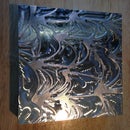Introduction: Sound Lamp
During my residency I am developing an omni-directional loud speaker that can both play given sounds, as well as generate its own soundscape. This instructable is to document the scale model development for this project.
Step 1: Design of the Sound Lamp
The basics of the initial design were born out of an installation we produced in Los Angeles in 2014. To further this exploration, the sound lamp was developed into a more precise project that would take advantage of the tools available at Pier 9, specifically the DMS 5 axis router. To build the scale model, however, several technologies needed to be used in order achieve a reliable and accurate result quickly.
Attachments
Step 2: Prototype Production
The initial scale model, or prototype, was 3d printed in multiple parts and then assembled. Using tight tolerances and a very limited amount of Tacky glue, the entire object was printed and assembled in under 24 hours.
Step 3: Prototype Base and Cover
Instead of having this prototype simply float in space, I put together a base and enclosure that would ground the piece while also protecting it. The base is made out of solid walnut that is milled on the DMS, and the cover is a simple glass cloche that I purchased off amazon.
Step 4: Milling the Base - Test
Before dedicating the toolpath to the walnut, I first tested it on a block of foam to ensure that no problems would be encountered. This was imperative, as I had to run the job several times to work out kinks in the toolpaths that would have ruined the walnut.
Step 5: Milling the Base - Final
Once all toolpaths were proven, the final pass was made on the walnut using full 3+2 functionality.
Step 6: Prototype - Final
Once all pieces were finalized and finished, the prototype was assembled into its final form.
Step 7: Final Thoughts
Initially, the purpose of this prototype was to suss out any formal issues with the complex geometry. What happened in addition was an opportunity to learn and develop the skills necessary to operate the same equipment that I will be using to produce the larger final object. It was a fantastic experience and the DMS is an amazing machine.






